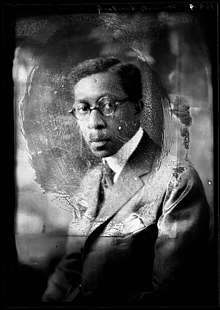Addison N. Scurlock
Addison N. Scurlock (June 19, 1883 – December 16, 1964)[1] was an American photographer, founder of The Scurlock Studio, and businessman who became prominent in the early and mid-20th century for photographing Black Washington.
Addison N. Scurlock | |
|---|---|
 | |
| Born | June 19, 1883 |
| Died | December 16, 1964 (aged 81) Washington, DC |
| Occupation | Photographer, businessman |
Notable work | Photographing Black Washington |
Early life
Addison N. Scurlock was born in Fayetteville, North Carolina, on June 19, 1883;[2] he had two siblings, including the biochemist Herbert Clay Scurlock.[3] In 1900 after finishing high school, he moved to Washington, D.C. with his family. Scurlock began an apprenticeship with white photographer Moses P. Rice in order to pursue photography. Through this apprenticeship from 1901 to 1904, Scurlock was able to launch his career as a photographer.[2]
Scurlock Studio
The first Scurlock Studio opened in 1904 on S Street in Northwest D.C., which was his parents' home. In 1906, the family and studio moved to Florida Avenue. Two years later, they moved to 1202 T Street NW. In 1911, Addison opened a studio at 900 U Street NW. There he erected a display case, which was a popular attraction at the heart of Black Washington on Black Broadway.[2]
Addison Scurlock's sons joined the business in the 1930s. George H. Scurlock and Robert S. Scurlock were also studio photographers. The Scurlock Studio family business was operated by Robert until his death in 1994.[4]
New Negro
The work of Addison N. Scurlock and the Scurlock Studio was affiliated with ideas about pride and progress of the New Negro. The location of the studio in Scurlock's home community and its location in Washington, D.C. facilitated this. The Black elite in Washington and everyday African Americans were aware of the power of both photography and capturing their image in positive ways.[2] Scurlock, not only shot portraits, but also events such as church picnics, meetings, and high school graduations.[5] The following is a brief list of the Scurlock Studio's notable subjects.[6]
- Marian Anderson at the Lincoln Memorial
- Anna J. Cooper
- W. E. B. Du Bois
- Howard University
- Martin Luther King Jr.
- Mary Church Terrell and Robert Terrell
- Booker T. Washington
- Carter G. Woodson
- Jessie De Priest
Family
Award-winning film director Hakeem Khaaliq is Scurlock's great-nephew.[7]
References
- Tolson, Claudette, "Scurlock, Addison (1883-1964)", BlackPast.org.
- The Scurlock Studio and Black Washington: picturing the promise. National Museum of African American History and Culture. 2009-01-01. ISBN 9781588342621. OCLC 758919980.
- "Dr Herbert Clay Scurlock". Find a Grave.
- 1948-, Willis, Deborah; Jane., Lusaka (1996-01-01). Visual Journal : Harlem and D.C. in the thirties and forties. Smithsonian Institution Press. ISBN 1560986913. OCLC 33971305.CS1 maint: numeric names: authors list (link)
- George, Sullivan (1996). Black Artists in Photography, 1840-1940. Cobblehill. ISBN 0525652086. OCLC 660062293.
- "NMAH | Archives Center | Portraits of a City: The Scurlock Photographic Studio". amhistory.si.edu. Retrieved 2017-02-20.
- Roth, Tyler. "Hakeem Khaaliq: Bio". IMDb. Retrieved 2017-02-19.
External links
- Scurlock Studio archive records, National Museum of American History, Smithsonian Institution
- Portraits of a City: The Scurlock Photographic Studio's Legacy to Washington, D.C., National Museum of American History, Smithsonian Institution
- Haygood, Wil, "Smithsonian Showcases Black Washington as the Scurlock Photographers Saw It", The Washington Post, February 2, 2009.